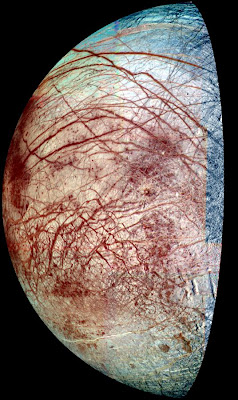
How different does the world look from 100,000 feet in the air? How do cities and suburbs, fields and forests appear when viewed from a vantage point of nearly twenty miles above Earth's surface?
Through an innovative program at
NASA's Glenn Research Center in Cleveland, local high school students have the opportunity to make these discoveries firsthand while learning practical math, science and engineering skills. Participants in the BalloonSAT Exploring Program launch a 6-foot diameter weather balloon, complete with experiments and cameras, into the space-like regions of Earth's upper atmosphere.
Exploring with Balloons
The Exploring Program is affiliated with the Boy Scouts of America. This program is designed to give high school students opportunities to experience different potential careers. Throughout the country, students in the Exploring Program learn from various professionals -- like firemen, police officers and medical workers -- about the skills necessary for these jobs. At Glenn, students explore what it's like to be a scientist or engineer in one of four Exploring Posts: Aeronautics, Computer, Human Space Exploration and BalloonSAT. Stephanie Brown-Houston, from the Glenn Educational Program, is the program manager for the Exploring Program → at Glenn.
The use of weather balloons as satellites (BalloonSAT) first began at Glenn a decade ago as a way of investigating solar cell calibration in space. A small payload which tracked the sun was suspended by a weather balloon and flown to gather data. The balloon served as an inexpensive high-altitude launch system.
The BalloonSAT Exploring Post 632 began in 2004. Dr. David Snyder, a physicist and electrical engineer in the Photovoltaic and Power Technologies branch of the Power & In-Space Propulsion division at Glenn, is the lead advisor for BalloonSAT Exploring Post.
"The overall goal is to give high school kids a chance to explore these professions," Snyder says. "It's about getting them interested in science and space and technology."
Learning by Doing
Each academic year, a group of 10 to 15 high school students join the BalloonSAT Exploring Post. These diverse students, from multiple high schools around the Cleveland area, work together to perform one or two launches every year. When the first launch occurs, it is more of a demonstration launch and takes place early in the program, in the fall. The second launch, which takes place in early spring, is coordinated and executed by the students and features the experiments they designed.
"BalloonSAT attempts to simulate a satellite mission," Snyder says. "We give students the chance to design experiments and fly them with a flight program, and get results."
The students work all year to research, develop, design and fabricate experiments that will be flown when they launch their balloon. In the seven missions that BalloonSAT has flown, dozens of student-designed experiments have been launched 100,000 feet in the air.
Previous experiments have included:
* Exposure experiments with rubber bands, seeds and mold
* Light and temperature sensors
* Aerogel particle capture
* Cosmic ray detection
* Geiger counters
* Electronic compass correlation
* Carbon Dioxide/Ozone detectors
* Solar cell measurements
* Latex balloon expansion
* Yeast growth and carbon dioxide generation
This year's launch, which is schedule for April 24, includes a variety of experiments such as:
* 3-D photography
* Video image transmission
* Chemical hand warmer testing
* Electric field disturbances
* Glass fragility during flight
* Wood glue exposure
* Humidity measurements
The students spend the year preparing for the launch; the multi-faceted project teaches the students numerous skills.



































 The northeastern U.S. was subjected to heavy flooding and damage from late winter storms, and the Geostationary Operational Environmental Satellite, GOES-12 captured a movie of those storms as they dumped heavy rainfall between March 8 and 16, 2010.
The northeastern U.S. was subjected to heavy flooding and damage from late winter storms, and the Geostationary Operational Environmental Satellite, GOES-12 captured a movie of those storms as they dumped heavy rainfall between March 8 and 16, 2010.


